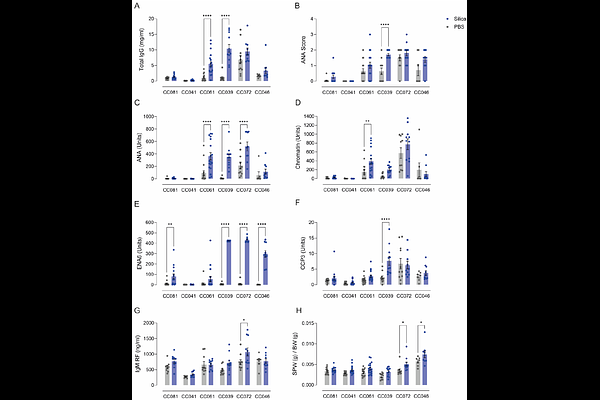Crystalline silica exposure induces multiple systemic autoimmune phenotypes including inflammatory arthritis and nephritis in Collaborative Cross mice with differing sub-clinical autoimmune profiles.

Crystalline silica exposure induces multiple systemic autoimmune phenotypes including inflammatory arthritis and nephritis in Collaborative Cross mice with differing sub-clinical autoimmune profiles.
Janssen, L. M.; de Ocampo, C.; Kono, D. H.; Hoet, P. H. M.; Pollard, K. M.; Mayeux, J. M.
AbstractInhalation of crystalline silica dust, an occupational hazard, has been strongly associated with the development of autoimmune connective tissue diseases, such as rheumatoid arthritis and systemic lupus erythematosus. However, it remains unclear if silica-mediated autoimmune disease requires preexisting subclinical autoimmunity, and to what extent the severity of the preexisting condition influences silica-induced disease. The aim of the current study was to examine whether silica-mediated autoimmune disease requires preexisting subclinical autoimmunity, using the Collaborative Cross (CC) mouse model system, recognized for its ability to mimic the genetic diversity observed in human populations. Sixty-one CC strains were assessed for the presence of subclinical autoimmunity via autoantibodies and inflammatory markers. Six CC strains, chosen to represent a range of subclinical autoimmunity, were exposed transorally to 5 mg silica or PBS and examined 12 weeks later for lung inflammation, autoantibody responses, total immunoglobulin levels, and the manifestation of glomerulonephritis and autoimmune arthritis. Results indicated a spectrum of spontaneous subclinical autoimmunity among naive CC strains, with silica exposure leading to significant pulmonary inflammation and systemic autoimmunity, including glomerulonephritis and synovitis. Notably, strains with pre-existing subclinical autoimmunity showed more severe disease outcomes post-exposure.